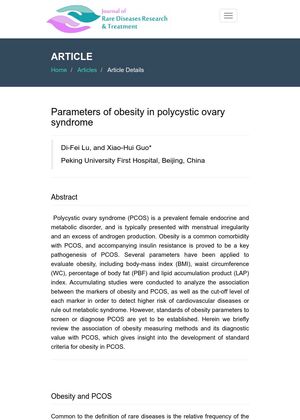TLDR Obesity is common in PCOS patients and early treatment is important for their heart and metabolic health.
In 2016, Di-Fei Lu and Xiao-Hui Guo from Peking University First Hospital conducted a study on 400 subjects to examine the relationship between obesity and Polycystic ovary syndrome (PCOS). They found that obesity is a common comorbidity with PCOS, with a rate of 32%. Parameters such as body-mass index (BMI), waist circumference (WC), percentage of body fat (PBF), and lipid accumulation product (LAP) index were significantly increased in PCOS patients. For example, in a study of 300 Chinese women with PCOS and 110 controls, the cut-off points of WC, BMI, and PBF were 80.5cm, 26.6kg/m2, and 29%, respectively. The study concluded that early diagnosis and intervention for obesity in PCOS patients is crucial for metabolic and cardiovascular outcomes. However, the standards of obesity parameters to screen or diagnose PCOS are yet to be established.
 1514 citations
,
December 2011 in “Fertility and sterility”
1514 citations
,
December 2011 in “Fertility and sterility” Experts agree that PCOS affects women's health in complex ways, but more research is needed to understand and treat it effectively.
 45 citations
,
February 2012
45 citations
,
February 2012 Obese women with PCOS are more likely to have fatty liver disease.
 April 2023 in “Clinical Chemistry and Laboratory Medicine”
April 2023 in “Clinical Chemistry and Laboratory Medicine” The document concludes that inflammation markers can be used in diabetes, vitamin D3 affects immune pathways, hyperthyroidism changes hormone levels, androgen levels help diagnose Adrenocortical Carcinoma, erectile dysfunction is linked to diabetes, hypogonadism is common in HIV-infected males, and hormones can be biomarkers for various conditions.
 155 citations
,
March 2006 in “The American Journal of Medicine”
155 citations
,
March 2006 in “The American Journal of Medicine” Women with PCOS have heart-related issues not because of obesity, but due to insulin resistance and low adiponectin levels.
 20 citations
,
October 2008 in “European journal of endocrinology”
20 citations
,
October 2008 in “European journal of endocrinology” Lower lipin 1β in belly fat is linked to insulin resistance in people with polycystic ovary syndrome.
22 citations
,
January 2012 in “Obstetrics and Gynecology International” Obese women with PCOS have more cardiovascular risk factors, and waist-to-stature ratio is a better health marker than waist-to-hip ratio.





